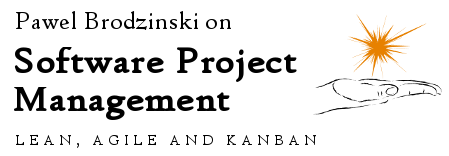If I got a dollar each time I heard someone mentioning that they’d like to get more feedback I would be filthy rich by now. Heck, if I got a dollar each time I personally said that I would still got a decent sum. Most of us do want and like to get feedback. Most of us would love to get more of that.
There’s obviously one thing to consider, which is what kind of feedback and received in what context is most useful for us. I’ve heard a lot of theories on that. One example is that we should always focus on positive or supportive feedback as people would improve their weaknesses subconsciously while they’re working on their strengths. Another is infamous feedback sandwich, which tells that each critical bit should but in the middle of two supportive ones. There are dozens of these.
On one hand there’s a bit of truth in each. On the other I call bullshit.
I don’t believe there’s a single, universal way of delivering and / or receiving feedback that works in majority of cases. Personally, while I like to hear positive feedback as it makes me feel good, I really learn when I get critical feedback. In fact, it doesn’t even have to be very constructive or factual feedback; I typically can make much sense out of non-constructive opinions too. And I don’t give a damn whether you add a sandwich to the mix.
There are better ways of delivering feedback when we think about an individual context, but there is a universal answer in a general case. This means that the most useful feedback should be adjusted to the person who receives it. A nice thing is that we can tweak the situation so we get what works for us.
If you learn from feedback in a similar way that I do, meaning that critical feedback is what makes you change, the following part is for you.
I learned about the idea of ritual dissent some time ago. Back then I didn’t even know that it is Dave Snowden who should be attributed for creating it. Anyway, the basic idea is to create a situation where a group tears an idea apart looking for all the potential risks or holes. After a spokesperson presents an idea while everyone else remains silent, there’s a part when everyone dissents the idea while a spokesperson remains silent.
There may be two goals in doing that. One is obviously improving the idea itself by making it risk-proof. The other part is that ritual dissent can be treated as a listening exercise. It’s not that easy to remain silent when someone tears your idea apart. At the same time this is what differentiates it from a futile discussion full of personal opinions.
So here’s an idea: if you look for critical feedback you can use the same pattern in a personal context.
No, it’s not a theoretical idea. I’ve done that.
It hurt. A freaking lot.
And I got more of what I wanted in half an hour than over the course of past year.
And it was awesome. Once emotions wore out, that is.
The thing is that adopting ritual dissent in personal context is, well, very personal. I was asking to be criticized. In fact, not-critical feedback was forbidden. No matter how much I learn from critical feedback it was nothing pleasant.
I would even consider that idea as “don’t try that at home” one unless one has self-awareness in terms of how they’re going to react for such critique. Having a psychologist around when doing that wouldn’t be a bad idea.
There are a couple things that make it work but two are essential. One is trust. I don’t say that everyone needs to fully trust a person being dissed. What is full trust anyway? However, there has be a decent level of trust so that anything that gets said won’t be used again anyone in any way. It may make the whole thing a bit tricky especially for managers or leaders where some sort of power relationship is involved.
At the same time there’s a lot of followership. Once a few people who feel safe start dissenting others join. Especially when they see that a dissented person doesn’t break the rules and keeps the mouth shut.
Another thing that makes personal ritual dissent work is listening, which is an inherent part of the exercise. It is a double-edged sword. On one hand the dissed person remains silent so the whole thing doesn’t turn into futile discussion. On the other the silence creates the pressure on the group. Someone eventually has to speak up even if it means going out of their comfort zone.
An interesting thing is that it’s nothing pleasant on either end. The exercise, which we run mid-day, was basically a killjoy. At the same time it spurred a lot of spin-off discussions afterwards, which is a reason why I wouldn’t do it at the very end of a day.
The best part is that getting critical feedback is not the ultimate value of the exercise. Since it creates a lot of tension and moves people out of the comfort zones it breaks some mental barriers that people had, thus makes sharing feedback later way easier.
After all sharing one critical opinion is nowhere close to dissing someone collectively for half an hour in a row.
Finally, some of feedback won’t be really addressed to the person who asked for a personal ritual dissent. It may be formulated in a way as it was so, but the real addressee would be somewhere else in a room and hopefully they’d get it too.
So if feeling like shit for (at least) a few hours is a price you’re willing to pay for a ton of valuable feedback, this is an idea for you. Would you dare?


 Subscribe RSS feed
Subscribe RSS feed Follow on Twitter
Follow on Twitter Subscribe by email
Subscribe by email



4 comments… add one
Ritual Dissent is a powerful method, but it’s critically important to understand the meaning of ritual, a key concept in anthropology, in Ritual Dissent. The use of ritual establishes constraints by framing the social experience and depersonalises the dissent.
Robert H. Winthrop defines a ritual as “a formalised, socially prescribed symbolic behaviour. […] a meaningfully patterned social act.”
Every form of dissent doesn’t qualify as Ritual Dissent, and can be highly damaging if the nature of ritual in the dissent isn’t properly understood by those employing it and those engaging in it.
Cognitive Edge’s Ritual Dissent sometimes uses masks as artefacts in the ritual to hide the face of the person who has presented an idea which is being subjected to dissent. When masks are not available, they turn their chairs to face away from those dissenting.
Ritual Dissent can be a cathartic experience, but the purpose of ritual is to shield and guide the participants through what could otherwise be a destructive process and an exercise in subjucation and suppression.
Kevin Carrico of Stanford University says rituals “bring people together and pull people apart; they frame experience or are themselves re-framed; they help people see who they are and who they are not; they exercise power and resist power; and every once in a while […] they simply perplex their intended audience.” (http://www.culanth.org/curated_collections/4-ritual)
– Mika Latokartano (@ImaginaryTime)
@Mika – I know what is the role of turning chairs in Cognitive Edge’s Ritual Dissent. We don’t want the dissent to get personal.
Thing is, that in the context of getting feedback we actually want it to be personal. That’s the whole point of adopting ritual dissent to such a context.
In my case we’ve had a discussion up front what kind of setup we prefer and decided to go without turning chairs, which made it harsher for me but less awkward for the group. After all they were talking to me and about me and not about just an idea.
I agree that making dissent a personalized experience may be damaging. I wouldn’t do that a few years ago. I wouldn’t advise doing that unless someone has high self-awareness how they deal with critical feedback and how valuable it is for them.
At the same time the frame I propose fits the definitions you mention. The whole exercise is structured, constraints are clearly defined, there’s a strong pattern in it. At the same time there’s exercising power (on group’s end) and resisting power (on dissented individual’s end); it helps people see what they are.
In either case I don’t insist on the name. Since the format was inspired by the Cognitive Edge’s exercise I believe it’s fair to share the credits. The value is not in the name, but in what one gets from the exercise.
The method (in various configurations) has been in use in many settings like theatre and drama groups. I saw it used already in the 80-ies when the theatre troupe sat on the stage with backs towards each other in a circle and gave feedback to each member.
Similar method has been the staple of the Swedish military leadership programme since ages but of course being the military it is expected that you listen face to face in the middle of the circle when people provide feedback. Part of the experience is to create trust that your peers will dare to be straightforward in their communication with you and provide feedback that is free from personal values.
Done right you will get a lot of Information & Insight that you probably would not have learned on your own in a million years . There are many ways to “soften” the impact to ones ego but also paradoxally with passing of time the military way begins to feels “safer” in providing you crucial feedback.
Keep up the good work and give us an update after awhile how your personal feedback method works.
-Rolf
@Rolf – Thank you for a comment adding depth to the experiment. Interestingly enough, it is another time when I hear how actors use techniques that, in our context, would be considered radical.